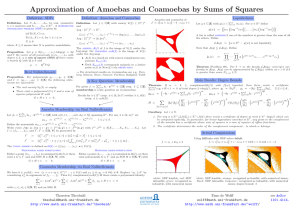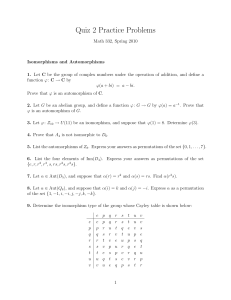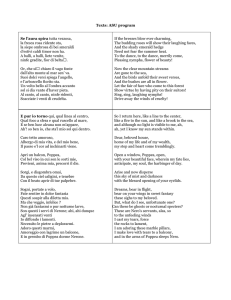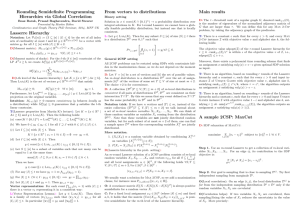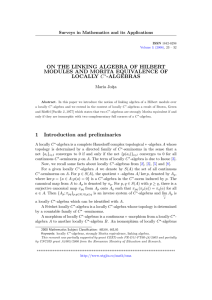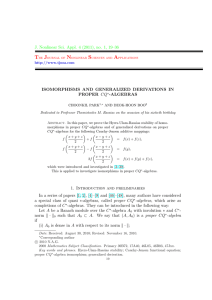PRODUCTS AND D) SEPARABLE INJECTIVITY
advertisement
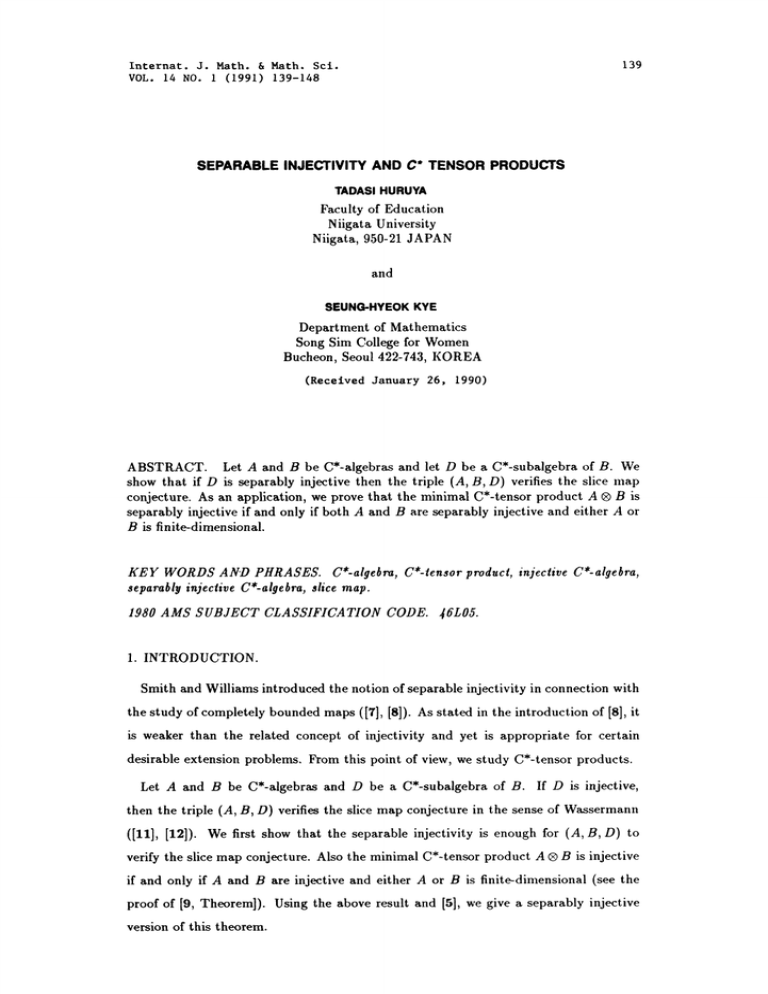
139
Internat. J. Math. & Math. Sci.
VOL. 14 NO.
(1991) 139-148
SEPARABLE INJECTIVITY AND C" TENSOR PRODUCTS
TADASI HURUYA
Faculty o[ Education
Niigata University
Niigata, 950-21 JAPAN
and
SEUNG-HYEOK KYE
Department of Mathematics
Song Sim College for Women
Bucheon, Seoul 422-743, KOREA
(Received January 26, 1990)
ABSTRACT. Let A and B be C*- algebras and let D be a C*-subalgebra of B. We
show that if D is separably injective then the triple (A, B, D) verifies the slice map
conjecture. As an application, we prove that the minimal C*-tensor product A (R) B is
separably injective if and only if both A and B are separably injective and either A or
B is finite-dimensional.
KEY WORDS AND PHRASES. Ca-algebra, C*-tensor product, injective Ca-algebra,
separably injective C*-algebra, slice map.
1980 AMS SUBJECT CLASSIFICATION CODE.
1.
46L05.
INTRODUCTION.
Smith and Williams introduced the notion of separable injectivity in connection with
the study of completely bounded maps
([7], [8]). As stated in the introduction of [8], it
is weaker than the related concept of injectivity and yet is appropriate for certain
desirable extension problems. From this point of view, we study C*-tensor products.
Let A and B be C*-algebras and D be
a
C*-subalgebra of B. If D is injective,
then the triple (A, B, D) verifies the slice map conjecture in the sense of Wassermann
([11], [12]). We
first show that the separable injectivity is enough for
(A,B,D) to
verify the slice map conjecture. Also the minimal C*-tensor product A (R) B is injective
if and only if A and B are injective and either A or B is finite-dimensional
proof of [9, Theorem]). Using the above result and [al, we give
version of this theorem.
a
(see the
separably injective
T. HURUYA AND S. KYE
140
2. PRELIMINARIES AND NOTATION.
Let A and B be C*-algebras and let A Q B denote their minimal (i.e., spatial) tensor
product. Let L, denote the (’,*-algebra of all, x
integer
n.
If
(j(R)id,)(a,i)
A
B is
a
linear map then
,
(R)
7t
complex matrices for
id,, A (R) M,
a positive
B (R) M, is defined by
is said to be completely positive if each (R) id, is positive.
(i(a,)).
A C*-algebra D is said to be injective if given C*-algebras E C_ F, any contractive
E
completely positive map
V F
D. We say that
a
D has
a contractive
conpletely positive extension
C*-algebra D is separably injective if given separable C*-
algebras E C_ F, any contractive completely positive map
F
completely positive extension
weaker than one in
E
D has a contractive
D. The separable injectivity in this paper is
([7], [8]) and both coincide for commutative C*-algebras. A compact
ltausdorff space is said to be substonean if every two disjoint co-zero sets have disjoint
closures. A compact Hausdorff space X is substonean if and only if C(X) is separably
injective
[7, Theorem 4.6].
A C*-algebra D is said to be subhomogeneous if every irreducible representation is
finite-dimensional with bounded dimension. In particulr, it is said to be t-homogeneous
if every irreducible representation is n-dimensional. If D is subhomogeneous then we
identify the spectrum D with the primitive ideal space
For
1, 2 let Di be a C*-algebra and let hi
[2, Chapters 3 and 4].
D.
The right slice map
R,,
D (R) D
D2 and the left slice map L, D (R) D D are unique bounded linear
R,,(zt (R) z) h(zt)z and L(z (R) z) h(z)z [10]. For C*subalgebras Ai of Di, we define the Fubini product F(At,A2, Dt (R) D2) of At and A2
with respect to D (R) D [11] by
maps satisfying
F(A, A, Di (R) D)
{z q Dt (R) D2- R,, (z) q A2 and L,(z) q A1
for all
ht
q
D’ and h D }.
For fixed C*-algebras A1 and A, F(Ai, A, D (R) D2) depends on D (R) D2. But they
are all isomorhic and are the largest among them if Dt and D are injective. We denote
by
A (R)F A: any one of these isomorphic Fubini products of A
B be C*-algebras and let D be
and
A [4]. Let A and
C*-subalgebra. The triple (A, B, D) is said to verify
the slice map conjecture if F(A,D,A (R) B) A (R) D [21.
a
3. THE SLICE MAP PROBLEM.
A C*-algebra A is said to have property (S) if (A, B, D) verifies the slice map conjecture for every C*-algebra B and every C*-subalgebra D of B
[12]. We now consider a
property (S’) as follows. A C*-algebra D is said to have property (S’) if (A, B, D) verifies the slice map conjecture for every C*-algebra A and every C*-algebra B containing
SEPARABLE INJECTIVITY AND C*-TENSOR PRODUCTS
141
D. Subhomogeneous or injective C*-algebras have property (S’) [11].
THEOREM 1. Let D be a C*-algebra. If D is serarably injective, then D has property
(s’).
F(A, D, A(R)
PROOF: Let A be a C*-algebra and B a C*-algebra containing D. Let r
B). Then there exists a sequence {rn} such that a’, n) a(i, n)(R)b(i, ..), lim,,,,
where each a(i, n) A and each b(i, n) B. Let Bo be the C*-subalgebra generated
1,...,m(n),n 1, 2,... } and let Do be the C*-subalgebra of D
generated by {Rn (x): h A* }. Then we have
by {b(i,n)
Do C_ Bo,
x
F(A, Do, A (R) Bo)
[4, Lemma 5]. By hypothesis, there exists a contractive
completely positive map b" B0 D which extends the identity embedding of Do into
by a sinila.r argument of
D. Then
Rh((IA (R) b)(:))= dp(Rh(:))
(h A*).
Rh(:r.)
{Rh h A*} is total [10, Theorem 1],
F(A,D,A (R) B) C_ A (R) D.
Since
z
(IA
(R)
)(x)
A
(R)
D and
so
The opposite inclusion is immediate.
It is known that the direct sum of two C*-algebras having property (S’) has property
(S’). In order to show that Theorem 1 gives a new example having property (S’), two
results will be needed. In the proof of [7, Theorem 4.6], Smith and Williams obtained
the following lemma.
LEMMA 2. Let B and D be C*-algebras. Then there exists a one to one correspondence
between completely positive maps qb
B (R) M,,
D (R) M, and completely positive maps
D for any positive integer n.
We remark that O is not necessarily
O()IA(R)M,
B
0(lA
norm
preserving and that 0 satisfies that
for a C -subalgebra A of B, where
the restrictions of 0(b) and
O(gP)la(R)M"
and
0(IA
denote
b to A (R) M,, and A, respectively.
The proof of the following proposition is based on an idea of
[6,
Theorem
2.1].
PROPOSITION 3. Let D be a C*-algebra. I D is separably injective, then D (R) M,, is
separably injective for any positive integer n.
PROOF: Let A be a separable C*-algebra and let
b A
D (R) M, be
a contractive
completely positive map. Let B be a separable C*-algebra containing A. We will show
b has a norm preserving, completely positive extension B D (R) M,,.
Since the image (A) is separable, there exists a separable C*-subalgebra Do such
that
T. HURUYA AND S. KYE
142
that (A) C_
Do (R) 11,1,. Let A
and
D
denote the C*- algebras obtained by adjoining
identities to A and Do, respectively. Then the unital map
ff (a + al)
embedding of
b
Do
into D. Define the map
D
defined by
D which extends the identity
D (R) M, by 2(a) 7r((a)).
if2 A1
is a contractive completely positive map from
b. Hence we lnay
Using the
assume that
.
B
bl
(R)
a
Lemma 2,
A1
to D (R) M, which extends
u.
we have
the map 0(b)
A (R) M,
D
Since D is separably injective, there exists a completely positive
M,
. .
positive map
A has the identity
same notations as in
associated with
extension
Dx
(a) + al is completely positive by [1, Lemma 3.9]. By hypothesis, there
exists a contractive completely positive map r
Then
A
B
D of 0(). Again by Lemma 2
D (R) M,., such that 0(fin)
we have the
completely
b. By the remark about Lemma 2,
B D(R) Mn by (b) da(ubu).
ffa extends Define the completely positive map
Then b is an extension of If b E B with I b II_< 1, then
I ,(a)I1=11 .,.(,,a,,)I1<_11
.,.
IIII
,,,, I1_<11 ;.,,.(,,)I1=11 (,,)I1=11
II.
This completes the proof.
EXAMPLE 4. Let
N
be the
Stone-ech compactitication
of the set N of positive
integers and N* the corona set /N N. For each positive integer u put D,
Doo
M,. Let
each n.
that
D
C(N*) (R)
,
denote the C*-algebra of bounded sequences
D, for
{x, } such that
Then Doo is separably injective and has no decomposition Doo Do Di such
is subhomogeneous and
Prtoo’" For each n there exists
Di is injective.
a projection of norm one from
where 1,, denotes the identity of M,. The algebra
Theorem
4.6],
C(N*)
D, onto C(N*) (R) 1,,
is separably injective by
[7,
but is not injective. Then D, is separably injective by Proposition 3,
Doo is separably injective, but is not injective.
Suppose that Doo has a decomposition Doo Do Di. Then there exist central
projections p and q of Do such that p q 1, where 1 denotes the identity of Doo.
but is not injective. Hence
We have the sequence {p, ) of projections of C(N*) such that p {p, (R) 1,}. Hence
D, {z e Doo’ {Zn} with n e (C(N*)p,.,)(R)Mr, for all n}. Ifp, 0, there exists
an irreducible representation of
we have an
D, with dimension
integer no such that pn
0 for all n
D0 is subhomogeneous,
> no. Put Di.no {x Do,:, x,
n. Since
with z,
0 for all n < no}. Then Di., is not injective. On the other hand,
a
there exists projection of norm one from Di onto Di.no and hence Di.no is injective.
{z,}
This is a contradiction and completes the proof.
4. C*-TENSOR
In this section
PRODUCTS OF SEPARABLY INJECTIVE C*-ALGEBRAS.
we prove the following theorem.
143
SEPARABLE INJECTIVITY AND C*-TENSOR PRODUCTS
THEOREM 5. Let A and B be C*-algebras. The following two statements
are
equiva-
lent"
(i) A (R) B
is separably injective.
(ii) Both A and B
are separably injective and either
A
or
B is finite-dimensional.
C*-subalgebra of a C*-algebra D, for
1, 2, 3. Then, under
We need several lemmas.
LEMMA 6. Let Ai be
a
the obvious identification, we have
F(F(A,
(R)
A.,D,
(R)
D),Aa,(D, (R) D:)(R) Da)
F(A,, F(A, Aa, D (R) Da), D,
PROOF" Let z q. F(F(A,A:,Di(R)D:),Az,(D(R)D:)(R)D3) and hi q.
Then, we have
we have
because Lha(Z)
functionals
by
Rh,(R)ha(Z)
Lh:(ni,(z))
Rh,(Lh(z)) q_ A:,
D’ for/= 1,2,3.
A3,
_
_
R,, (z) e F(A2, Aa, D2 (R) D3).
L,=(R)la(z)
Ll,(Ll, a(z)) A1,
F(AI, A:, DI (R)D:) by the assumption. Since the family of all product
h (R) ha on D (R) Da
a standard
(D,. (R) Da)).
F(A,A2, D (R) D2) by the assumption. These imply that
because L,a(z)
Now,
Rh:(Rh,(Z))
(R)
is total, we obtain
for all h e (D2 (R) D3)*
L(z) At
approximation argument (see, for example, [11, Lemma
2.1]). Hence we
have
z q.
F(A, F(A:, A3, D2 (R) D3), D1
(R)
(D2 (R) D3)).
The reverse inclusion can be shown similarly.
LEMMA 7. Let A be an infinite-dimensional C*-algebra and D be a
non-subhomogeneous C*-algebra. Then D (R) A is not separably injective.
PROOF: Let B(H) be the C*-algebra of all bounded linear operators on a Hilbert space
H such that B(H) _D D (R) A. Since A is infinite-dimensional, there exists an orthogonal
sequence {A,, } of commutative C*-subalgebras of A. The C*-subalgebra generated by
{A, } may be identitied with the c0-sum n A,, of {An }.
Suppose that F(B(H),D (R) A,B(H) (R) B(H))
B(H) (R) (n (R) A). Then,
we have
T. HURUYA AND S. KYE
B(H)(R)F(D(nAn))
F(B(H),D(R)(r, An),B(H)(R) B(H))
B(tI)(R)(D(R) A).
C_ F(B(H),D(R) A,B(H)(R) B(H))
Hence, it follows that
B(H)(R)F(D(R)(nAn))
F(B(H),D(R)(O,An),B(H)(R)(D(R)A))
(by [12, Threm 4])
F(B(H),F(D,.A.,D(R) A),B(H)(R)(D(R) A))
(by Lemma 6)
F(F(B(H),D,B(H)D),An,(B(H)D)A)
F(B(H) @ D, .A., (B(H) @ D) @ A)
(by [12,Th,’em
(B(H) D) @ (,A,)
4])
=B(H)(D@(,A,)).
n(n An), this contradicts [5,
Theorem 3.2]. Hence F(B(H), (n A), B(H) @ B(H)) contains properly B(H) (D
A), and so D A is not separably injective by Theorem 1.
(,An)
Since D
is canonically *-imorphic to
LBMMA 8. Let A and B be Calgebr. I A
B is parably injtive, then both A
and B are separably injective.
PaOOF" Let E C_ F be separable C*-algebras. Let b E
A be
completely positive map. Let b be a positive element of B with II b
E
A (R) B by (x)
extension
1 F
(:) (R) b. Then
I
I1=
1. Define
has a contractive completely positive
A (R) B. Let h be a state of B such that h(b)
by bl(z) =/,((x)). Then
a contractive
is the desired extension of
1. Define
b.
1 F
A
This implies that A is
separably injective. A similar argument shows that B is separably injective.
The following lemma is a slight modification of the proof of
[8, Propositon 2.6].
LEMMA 9. Let A and B be C*-algebras and let A and B denote the C*-algebras
obtained by adjoining identities to A and B, respectively. I A (R) B is separably injective
then A
(R)
B is separably injective.
Paoor- Let E C_ F be separable C*-algebras and let
completely positive map. Choose
Am
and
Bo
q E
A
(R) B
be a contractive
be separable C*-subalgebras such that
q(E) _C Am (R) Bo + CI (R) Bo. By [8, Proposition 2.5] there exist positive elements
a E A,b E B and c q A (R) B of unit norm such that a,b, and c act as identities of
Am, B0 and the C*-subalgebra generated by Am (R) Bo and a (R) b, respectively. We note
that (a (R) b)(1 (R) d) a (R) bd (1 (R) d)(a (R) b) for each d ( Bo. Let h be the state of
A which annihilates A. Define
B
E A (R) B by (x) cqi(x)c and t? E
by t(z) R,((z)). By Lemma 8, B is separably injective. Then 0 has a contractive
145
SEPARABLE INJECTIVIT AND C*-TENSOR PRODUCTS
B. Define 6." F
completely positive extension 61 F
By hypothesis
CI(R)B by
has a contractive completely positive extension
6(x)= l(R)61(x).
g, F
,4B. Define
Ct F-- A B by
di(x)
Since
(z)
tnay
b)e(x)(a
(a
b) + (I
b)2)O2(x)(I
(a
b)2)
(a
be written
(a@b,(l_(a@b),))
(,(x)
0
) ((l-(ab)2)
ab
O(x)
t is a contractive completely positive map. To s
(z) y+ z,y AoBo, z CIBo. Then (z)
0
extends
,
E and write
let z
y+ zc and O(x)
y+czc
z.
Thus
()
(, )( + )( ) + (
)) (
(a
(
))
+ ( a) + ( (a )) ().
Hence A
B is separably injective.
A symmetric argument shows that A
B is separably injective.
LEMMA 10. t A be a unital innitdensional subhomogenus C*-algebra. Then
there exist a homomorphism
of A and a norm one projection
such that the image
(x(A)) is imorhpic to the Calgebra of all continuous functions on
me in,hire
compact Hausdorff space X.
Paoor" By [2, 3.6.3 Proposition] and the proof of [, Threm 3.2],
that there exists a cled twsid ideal J such that
A/J
we may sume
is finite-dimensional, J is
n-homogeneous and J is an infinite set.
Suppose first that J h a limit point. By [2, 3.6.4 Proposition] J is a locally compact
Hausdo spe. Thus there exists a clo twsid ideal J0 such that (J/J0)
infinite compt Hauo spe. Let
the center of J/Jo. Let
(J/J0)
an
X. Then C(X) may be identified with
"A
A/Jo be the quotient map. From [2, 3.6.4 Proposition]
for a $ A the map
tr,(A(a)) is continuous on J, where tr, denotes the normaliz
trace on M,. Note that ker A ker for eh A $ X. Define
(A) C(X) by
((a))(A)
It is ey to see that
Suppose
now that
and
tr,(A(a))
(a A,
X).
are desired maps.
J h no limit point. Let T be
a
non-empty set. t
(M,) be
(zx) such that z M, for all fi T and sup I ll<
and let (M,) be the ideal of t(M,) such that for eh > 0 II
1 for all but
the C*-algebra of (zx)
a finite number of indic
A.
T. HURUYA AND S. KYE
146
Let J
Y. Define p" A
.(M,*)
by
(a E A,,
p(a)(/)- ,(a)
Since Y is discrete, by
[2, 10.10.1]
we
(M,)/c.(M,*) denote the quotient
have p(J)=
c.(M,*).
map. Since
(pp)-l(O)
dimensional. Hence there exists a finite set
ltp(a)} spans pp(A). Then
{al,...a:}
_.
(M,,)-J, pp(A) is finit;e-
Let./,"
of A such that {lp(al),...
we have
c.(M,) + Cp(al)+-.. + Cp(a:).
p(A)
Let X be the one-point compactification of the set N of positive integers. Then
C(X)
(R)
lr, may be identified with the C*-algebra of convergent sequences of ele-
(m)
M,*. Let p(a,)
g,(M,). Passing to convergent subsequences,
there exists a sequence {A,*} of Y such that (m.) E C(X)(R) M,, for each i. Define
," e(/tl,*)-- e
{.} (/l/l,,) by
’((a,x)) (a.).
lnents of
Then t,p(a)
,
r(A)
e C(X)(R) M,
C(X) by
for a E A. Let r
,p. Then
r(A)
C(X)(R) M,,.
Define
,(-(,,))(..)
It is well known that b has the desired property.
Using Choi-Effros lifting theorem
[1], Smith and
Williams showed in the proof of [,
Lemma 3.3] that every quotient algebra of a nuclear separably injective C*-algebra is
separably injective. By this useful result
we have the
following lemma.
LEMMA 11. Let A be a nuclear separably injective C*-algebra. Let
r be a
*-homomorpbism of A and let B be a commutative C*-subalgebra of r(A). I there
exists a norm one projection qi
r(A)
B, then B is separably
B such that (r(A))
injective.
Ptool" Let E (::: F be separable C*-algebras and let
E
B be
a contractive
.
completely positive map. By the above remark, r(A) is separably injective. Then has
F
B
F r(A). Then 2
a contractive completely positive extension
Hence B is separably injective.
is a contractive completely positive extension of
(i) =: (ii). By Lemma 8, it suffices to show that either A or
B is finite-dimensional. To do this, we may assume that A and B are unital by Lemma
Ploo" o" THEOREM 5:
9.
are
infinite-dimensional. If A or B is non-subhomogeneous,
it follows from Lemma 7 that
A (R) B is not separably injective. This is a contradiction.
Suppose that A and B
Now if A and B are subhomogeneous, by Lemma 10 there exist *-homomorphisms
SEPARABLE INJECTIVITY AND C*-TENSOR PRODUCTS
rx, r2, infinite compact llousdorff spaces Xt, X. and norm one projections
147
0t r(A)
C(X:). By Le,nma 11 and [7, Theoren, 4.6] .\’, a,,d X. are
substonean. % may identify C(X)(R) C(X,.) with C(X x X). Then
(3 4) r G
r,.(AQ B) C(Xt X:) is a norm one projection such that b qi:(r Or.(AO B))
C(X x X). Again by Lemma 11 and [7, Theorem 4.6] X x X is substonean. But
C(Xt), ck r(B)
this contradicts
[3, Proposition 1.7].
(ii) := (i). Since a finite-dimensional C*-algebra is
a finite direct sum
of matrix
algebras, Propositon 3 implies that A (R) B is separably injective.
ACKNOWLEDGMENT: The second author
was
partially supported by Korea Sci-
ence and Engineering Foundation, 1989-90.
REFERENCES
M.-D. Choi and E.G. Effros, The completely positive lifting problem for C*-algebras,
Ann. of Math. 104(1976), 585-609.
2. J. Dixmier, C*-algebras, North-llolland, Amsterdam, 1977.
3. K. Grove and G.K. Pedersen, Sub-stonean spaces and corona sets, J. Funct. Anal.
1.
56(198,t), 124-143.
4.
5.
6.
7.
8.
9.
10.
11.
12.
T. lIuruya, Fubini products of C*-algebras, Tdhoku Math. J. 32(1980), 63-70.
T. lluruya and S.-II. Kye, Fubini products of C*-algebras and applications to C*exactness, Publ. RIMS, Kyoto Univ. 24(1988), 765-773.
R.R. Smith and J.D. Ward, Matrix ranges for llilbert space
operators, Amer. d. Math.
102(1980), 1031-1081.
R.R. Smith and D.P. Williams, The decomposition property for
C*-algebras, J. Operator Theory 16(1986), 51-74.
R.R. Smith and D.P. Williams, Separable "injectivity for
C*-algebras, Indiana Univ.
Math. J. 37(1988), 111-133.
M. Takesaki, A note on the direct product of operator
algebras, Kodai Math. Sere.
Rept. 11(1959), 178-181.
J. Toniyama, Applications of Fubini type theorem to
the tensor products of C*-algebr,
TShoku Math. J. 19(1967), 213-226.
J. Tomiyama, Tensor products and approximation
problems for C*-algebras, Publ.
RIMS, Kyoto Univ. 11(1975), 163-183.
Wassermann, The slice map problem for C*-algebras, Proc. London Math. Soc.

![5.5 The Haar basis is Unconditional in L [0, 1], 1 < 1](http://s2.studylib.net/store/data/010396305_1-450d5558097f626a0645448301e2bb4e-300x300.png)

